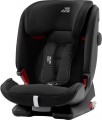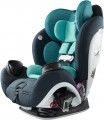Weight group
The weight of the child for which the car seat is designed.
In total, there are 5 main weight groups: 0 (0 – 10 kg; a rather rare option nowadays),
0+ (0 – 13 kg),
1 (9 – 18 kg), 2 (15 – 25 kg),
3 (22 – 36 kg). However, many car seats are produced that belong to several groups at once:
0 +/1 (0 – 18 kg),
1/2 (9 – 25 kg),
2/3 (15 – 36 kg),
0 + / 1/2 (0 – 25 kg) and even
1/2/3 (9 – 36 kg) and
0+/1/2/3 (0 – 36 kg). Such versatility affects the price, sometimes quite noticeably. On the other hand, a seat that matches several groups at once remains relevant for a child longer, and it usually costs less than two (or even more) separate products, each for a different weight category.
Note also that the weight group is directly related to age; refer to "Age range" for details.
ADAC test result
The results shown by the seat in crash tests according to the standards of ADAC — the General German Automobile Club, an authoritative European organization of motorists.
Car seats in such tests are evaluated in several categories, but in this point only one parameter is taken into account — the safety of the child, his/her protection in emergency situations. The results of such a test are indicated by the number of points; the fewer points in the end — the safer the product. It should be noted that the ADAC standards are much stricter than those by which the seat is evaluated during mandatory certification; tests are conducted with different directions of impacts (frontal and side), with dummies of different ages and so on. Therefore, the result of the ADAC test very reliably describes the real level of protection that the product provides in accidents.
According to this indicator, modern car seats can be divided into the following categories:
—
very good (< 1.5);
—
good (1.6 – 2.5);
—
satisfactory (2.6 – 3.5);
—
acceptable (3.6 – 4.5);
— unacceptable (more than 4.5).
The downside of a good value is usually a higher price; however, in an accident, that price may be a very small price to pay for the extra protection that can save your baby's life and health.
In c
...onclusion, it should be noted that ADAC test methods are constantly being improved and tests are conducted every year. Therefore, when choosing a seat and comparing it with its counterparts, you should also pay attention to the year of manufacture; as a rule, newer products with the same number of points give a higher actual level of protection than older ones.Age range
The age of the child for which the car seat is designed. Many models combine several age groups at once; such products, naturally, cost more, but remain relevant for the baby longer.
Note that this indicator is directly related to the weight group; Here are the main age ranges that are found nowadays, and the weight categories to which they correspond:
— 1 – 6 months (weight group 0); rare today.
—
1 – 12 months (weight group 0+); almost completely replaced the category "0".
—
8 – 48 months (weight group 1).
—
3 – 7 years (weight group 2).
—
6 – 12 years (weight group 3). Note that if only this weight category is indicated for the car seat, then it is a
booster: a lining without a backrest, which is placed on the standard car seat and allows the grown-up child to use "adult" seat belts. If the note "6 — 12 years" is combined with another weight category - then we have a full-fledged car seat with a backrest.
In conclusion, it is worth saying that this characteristic is not strictly defined: children of the same age may differ in development and build. So, when choosing a seat, first of all, weight should be taken into account, and then age; and if the seat corresponds to the child's height and build, there is nothing wrong with the age discrepancy.
Installation
—
Seat belt. Installation with the car seat belt. In weight groups 0, 0+ and 1, only the seat is secured in this way; the child's safety is ensured by the seat's own belts. In weight groups 2 and 3, the car belt is used to secure both the seat and the child.
—
Tor Tether. An additional harness to increase the security of fixation used in seats with Isofix and Latch systems (see below). One end of the harness is attached to the upper part of the backrest and the other end is attached to a special bracket installed in the floor of the car behind the seat or in the trunk. This reduces the likelihood of the seat being knocked over in a sudden braking or frontal impact and increases the overall safety of the small passenger.
—
Support leg. An additional attachment in the form of a support running from the bottom of the seat to the floor of the car. The purpose is similar to the Top Tether described above: it increases the safety of the seat and reduces the risk of the seat toppling when the car comes to a sudden stop. It is most often used with the Isofix system.
—
ISOFIX. The installation system for car seats in the weight category up to 18 kg is primarily found in cars from European manufacturers. The seat is secured with two locks in the rear lower part, with optional additional attachments at the top and/or b
...ottom. The design ensures foolproof installation, making it nearly impossible to install the seat incorrectly. Isofix requires the car to be equipped with suitable brackets, but even without them, these seats can usually be securely installed using the regular seat belt. However, this option may not be cost-effective, as seats with the Isofix system tend to be relatively expensive.
— LATCH. Installation system similar to Isofix. It is used mainly in American cars and, accordingly, in car seats of American manufacturers. The seat is attached at three points — two at the bottom of the seat and one at the top — so that the seat cannot be installed incorrectly. Like Isofix, seats with Latch also allow fixation with the normal car seat belt.Installation
—
Forward facing. Installing the car seat facing in the direction of the car. In this way, car seats of weight groups starting from 1 and above are installed.
—
Rear facing. Install the seat facing against the direction of travel of the car. This is how seats of weight groups 0 and 0+ designed for very young babies are installed. These babies have cervical muscles not yet sufficiently developed to hold their head in a more or less severe frontal impact, so when the seat is positioned in the direction of travel, such an impact can lead to damage to the cervical spine, up to fatal. The backrest of the seat prevents critical displacement of the head when positioned against the driving direction.
—
Sideways. An option used in some models for very young babies. These car seats are usually elongated carrycots that are difficult to fit into the car in any other way. Some models have a swivel/folding carrycot design, which allows to turn it into a car seat and turn it to be faced against the movement or in the direction of travel; nevertheless, in the form of a carrycot, such devices are still placed sideways, hence the name. Note that from a safety point of view, this option is generally less preferable than a rear-facing position, but such designs perform well in side impacts.
Equipment
—
Isofix base. The product is equipped with a separate Isofix base, which is fixed in the interior of the car on the appropriate fixing clips, and the car seat is installed directly on it. The use of the base provides reliable fixation of the car seat and reduces the risk of its incorrect installation. On the Isofix base are installed mainly car seats of age groups 0+ and 1, some models assume the possibility of placing seats for older kids. It should be noted that car seat models
without an Isofix base are also widely available on the market.
—
Removable cover. Removable car seat cover for cleaning and/or washing. This function is especially useful if the seat is used when feeding a kid.
—
Anatomical cushion. Depending on the age group, it can either be a special horseshoe-shaped cushion to support the kid's head (for the youngest ones who are still unable to hold their head on their own), or a special soft headrest that fixes the head from behind and to the sides (for older kids).
—
Armrests. Armrests refer to the handles placed on the sides of a seat where one can rest their elbows and forearms. They reduce fatigue in the neck and shoulders of a child during prolonged sitting.
—
Sun canopy. Plastic (most often) canopy to protect the kid fro
...m the sun or bright light.
— Foot cover. A cover that covers the kid's legs and lower body. It is used in seats of age group 0.
— Cup holder. A device used in car seats to hold a bottle of drink or formula for feeding. Most often done removable.Additional side protection
The car seat has structural elements that further protect the child from side impacts. At least such elements include sidewalls for head protection made of impact-absorbing material such as polyurethane foam; torso protection may also be provided. If you are looking for a car seat with the maximum level of protection, you should choose from models with
additional side protection.
Country of origin
The country of origin of the brand under which the product is marketed. Often indicated by the nationality of the company or the location of its headquarters. At the same time, the actual production capacity of the brand often differs from the country of origin.
The quality of products is more influenced by the organization of processes and quality control at all production stages than by geography. Therefore, biases against brands from specific regions are generally unfounded. Consideration of a brand's country of origin becomes relevant only when the goal is to actively support or avoid manufacturers from a particular state.

